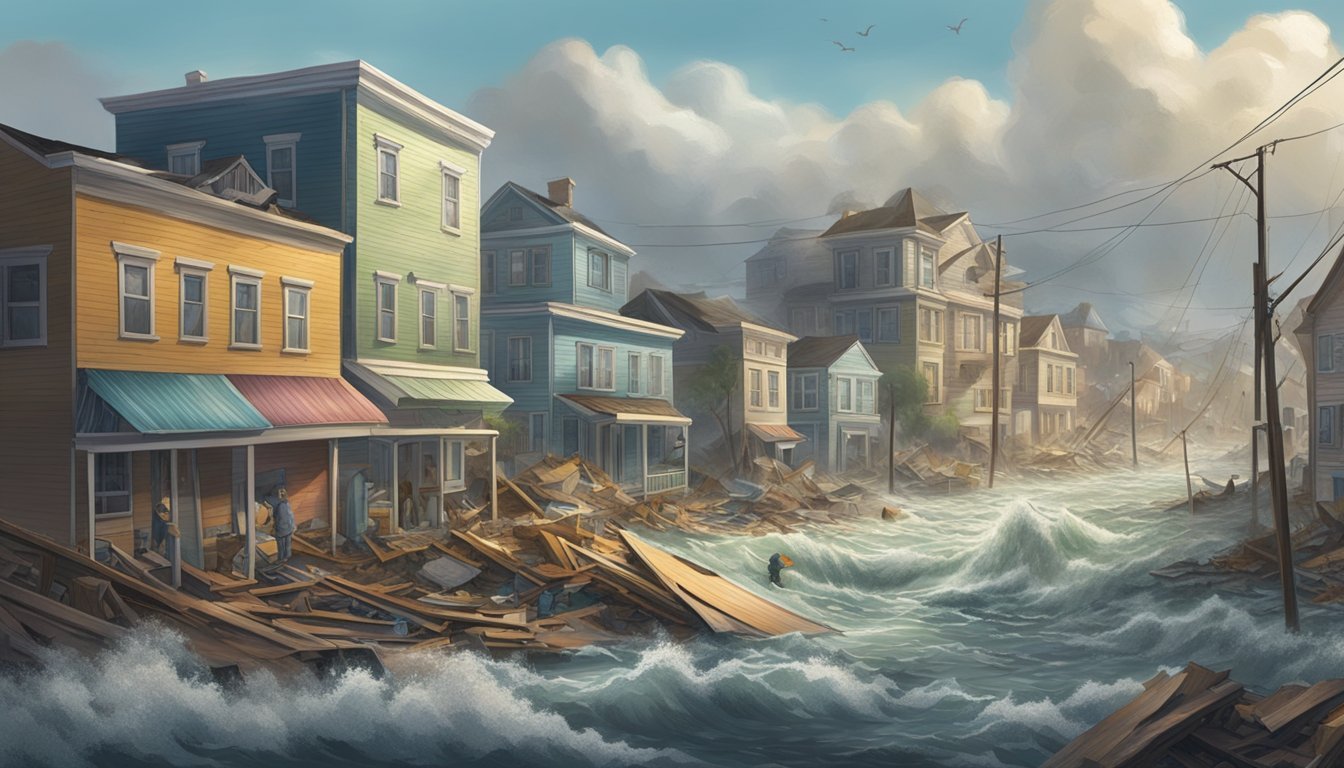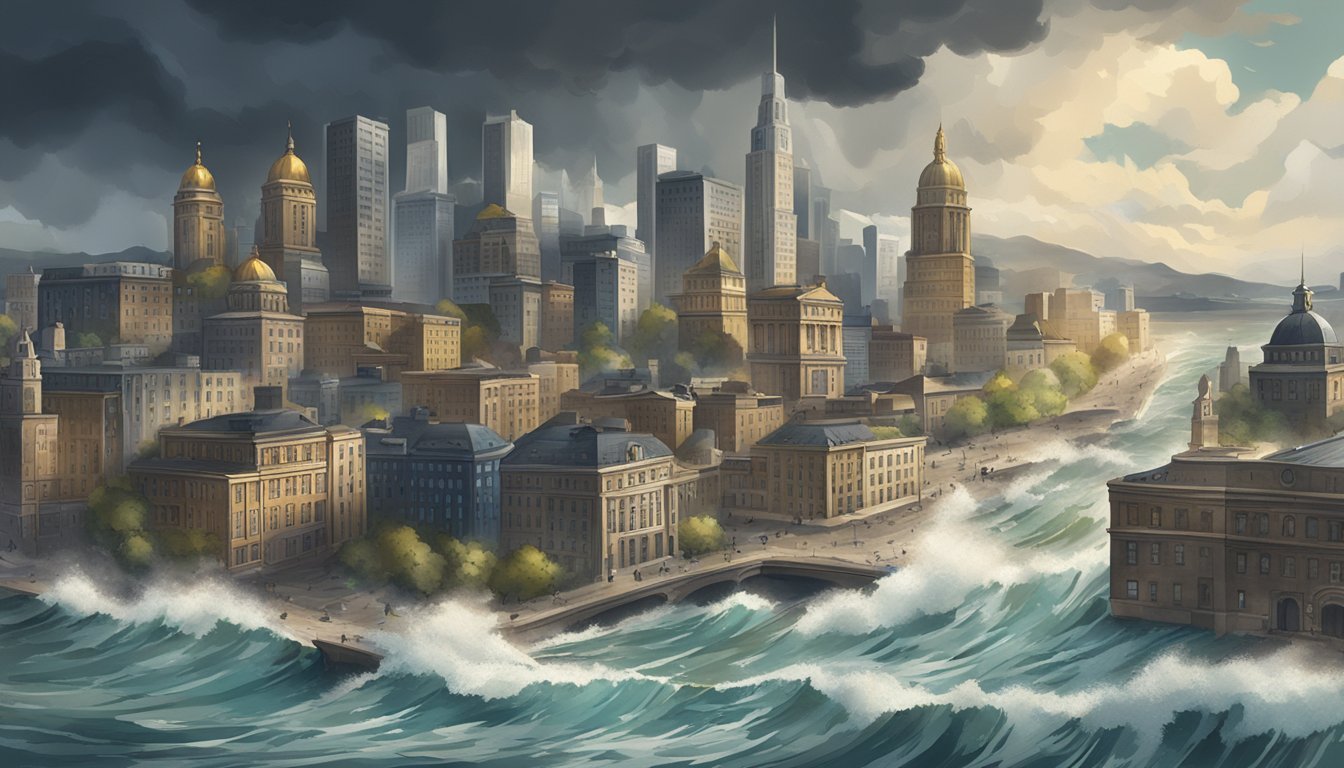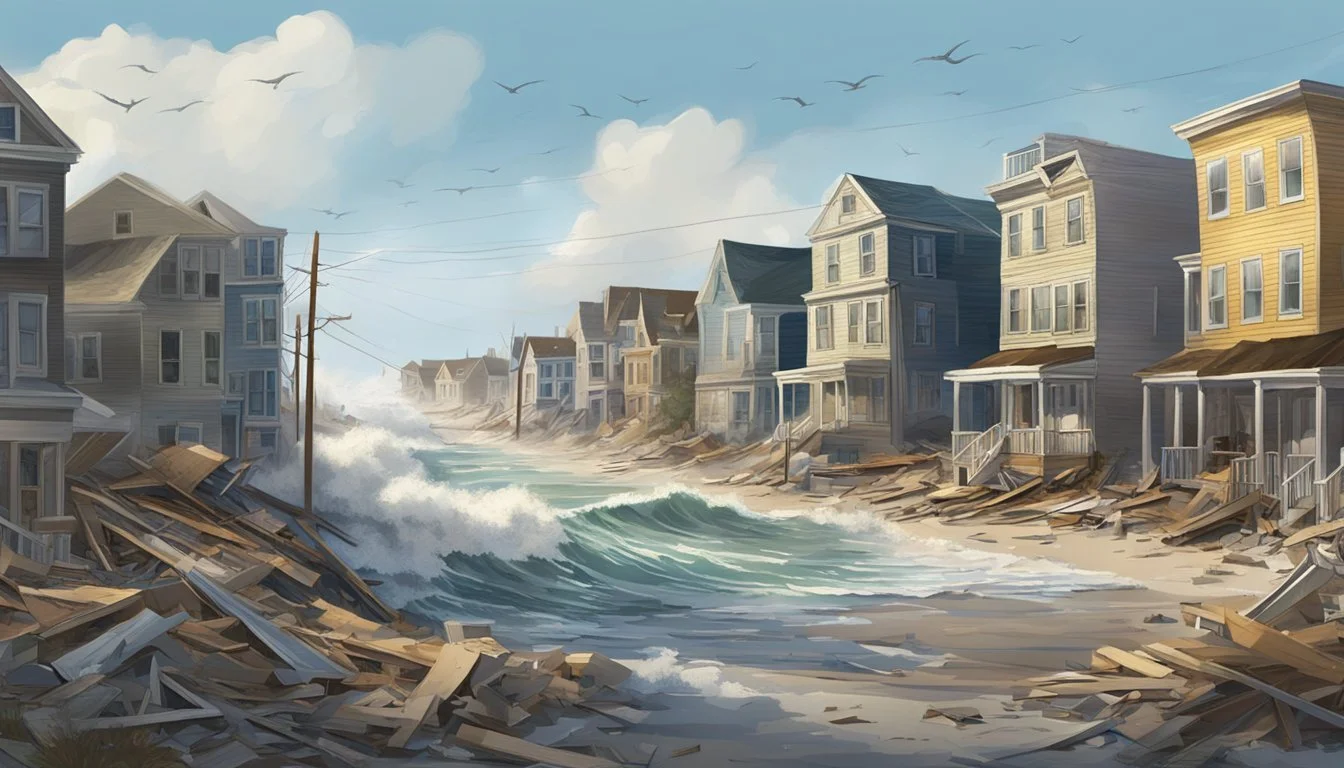5 Superstorm Sandy Documentaries That Changed 2012's Disaster Reporting
Reshaping Media Coverage of Natural Catastrophes
Superstorm Sandy devastated the East Coast of the United States in October 2012, leaving an indelible mark on the lives of millions. The storm's unprecedented impact sparked a wave of documentaries that transformed disaster reporting. These films not only chronicled the destruction but also shed light on the resilience of affected communities and the long-term challenges of recovery.
The documentaries produced in the wake of Sandy went beyond traditional news coverage, offering in-depth analyses of the storm's causes, effects, and aftermath. They explored the human stories behind the statistics, capturing the experiences of survivors, first responders, and local officials. This approach provided viewers with a more comprehensive understanding of the disaster's far-reaching consequences.
These films also played a crucial role in raising awareness about climate change and its potential impact on coastal communities. By examining the factors that contributed to Sandy's intensity, documentarians sparked important conversations about infrastructure, urban planning, and disaster preparedness. The lasting influence of these documentaries continues to shape public perception and policy discussions surrounding extreme weather events and climate resilience.
Superstorm Sandy Overview
Superstorm Sandy struck the northeastern United States in October 2012, causing widespread devastation. The storm's unusual path and intensity led to unprecedented damage across multiple states, particularly in New York and New Jersey.
Genesis of the Storm
Hurricane Sandy formed in the Caribbean Sea on October 22, 2012. It quickly intensified, becoming a Category 3 hurricane before making landfall in Cuba. As Sandy moved northward, it merged with a cold front, transforming into a massive hybrid storm system.
This unusual combination created a "Frankenstorm" with a diameter of over 1,000 miles. Sandy's central pressure dropped to 940 millibars, making it one of the most intense storms ever recorded in the Atlantic basin.
The storm's size and strength were fueled by warm ocean temperatures and a blocking high-pressure system over the North Atlantic. These factors steered Sandy directly toward the densely populated Northeast coast.
Path of Destruction
Sandy made landfall near Atlantic City, New Jersey, on October 29, 2012. The storm's powerful winds and record-breaking storm surge caused catastrophic damage along the coastline.
New York City experienced severe flooding, with water levels reaching 13.88 feet at Battery Park. Subway tunnels filled with seawater, and entire neighborhoods were submerged.
In New Jersey, the storm destroyed iconic boardwalks and left millions without power. Sandy's impact extended far inland, with heavy rainfall and snowfall affecting areas across the Mid-Atlantic and New England.
The storm resulted in 147 direct deaths and caused an estimated $65 billion in damage. Sandy's aftermath prompted significant changes in disaster preparedness and coastal resilience efforts throughout the region.
Impact on Affected Regions
Superstorm Sandy caused widespread devastation across the northeastern United States, with coastal areas bearing the brunt of the damage. Flooding and storm surge led to significant destruction in major urban centers and popular beach destinations.
New York City and Staten Island
New York City faced severe flooding and power outages. Lower Manhattan was submerged under several feet of water, shutting down the subway system and flooding tunnels. The financial district suffered billions in damages.
Staten Island saw some of the worst destruction in the city. Powerful waves and a 14-foot storm surge decimated coastal neighborhoods. Hundreds of homes were damaged or destroyed.
The storm claimed 43 lives in New York City. It exposed vulnerabilities in the city's infrastructure and coastal defenses.
The Jersey Shore and Atlantic City
Sandy made landfall near Atlantic City, causing catastrophic damage along the Jersey Shore. The storm surge reached 14 feet in some areas, destroying beaches, homes, and businesses.
Iconic boardwalks were reduced to splinters. A roller coaster from a pier in Seaside Heights ended up in the ocean, becoming a symbol of the storm's power.
Atlantic City's casinos closed for days, costing millions in lost revenue. Many coastal towns saw severe beach erosion that threatened oceanfront properties.
Inland Areas and the Caribbean
While coastal regions saw the worst impacts, inland areas also faced significant challenges. Widespread power outages affected millions across the Northeast and Mid-Atlantic states.
Heavy rainfall and snow caused flooding and road closures in states like Pennsylvania and West Virginia. Trees and power lines were downed by high winds.
In the Caribbean, Sandy caused extensive damage before reaching the U.S. Haiti, Cuba, and Jamaica experienced flooding and landslides. The storm destroyed crops and infrastructure in these vulnerable island nations.
Human and Environmental Toll
Superstorm Sandy inflicted severe damage on communities, infrastructure, and ecosystems along the U.S. East Coast. The storm's impacts were far-reaching and long-lasting, affecting millions of lives and reshaping landscapes.
Casualties and Public Health
Sandy claimed 117 lives in the United States. Most fatalities occurred due to drowning, falling trees, and carbon monoxide poisoning from improper generator use. The storm also created significant public health challenges.
Floodwaters contaminated with sewage and chemicals posed infection risks. Mold growth in flooded buildings led to respiratory issues for many residents. Disruptions to medical services left chronically ill patients vulnerable.
Children faced unique health risks from exposure to contaminated environments and the stress of displacement. Mental health impacts, including anxiety and PTSD, affected survivors across all age groups.
Infrastructure and Housing
Sandy's destruction of critical infrastructure was extensive. The storm damaged or destroyed:
Over 650,000 homes
Thousands of miles of roads and railways
Numerous power substations and transmission lines
Water and wastewater treatment facilities
Widespread power outages lasted for weeks in some areas. Public transportation systems in New York City were paralyzed. Many hospitals had to evacuate patients due to flooding and power loss.
The housing crisis was particularly acute. Tens of thousands of people were displaced long-term. Low-income and elderly residents faced major challenges finding temporary shelter and rebuilding their homes.
Environmental Quality
Sandy's environmental impacts were severe and varied:
Beach erosion and coastal habitat loss
Contamination of waterways with sewage and chemicals
Damage to urban forests and parks
Wildlife population disruptions
Salt water intrusion affected freshwater ecosystems and agricultural lands. Debris from destroyed structures polluted coastal waters and wetlands.
The storm also highlighted environmental justice issues. Low-income communities often faced greater exposure to toxic floodwaters and longer recovery times for environmental clean-up efforts.
Long-term monitoring revealed persistent contamination in some areas, affecting soil and water quality for years after the initial impact.
Disaster Response and Recovery
Superstorm Sandy triggered a massive disaster response and recovery effort. Federal, state, and local agencies mobilized to provide emergency services, coordinate evacuations, and support affected communities.
Emergency Services and Evacuation
First responders worked tirelessly to rescue stranded residents and provide medical care. Police and fire departments conducted door-to-door searches in flooded areas. The Coast Guard rescued over 250 people from rooftops and flooded homes.
Mandatory evacuation orders were issued for coastal areas in New Jersey and New York. Nearly 375,000 people evacuated in New York City alone. Emergency shelters opened to house displaced residents.
Public transportation shut down in major cities. Airports closed, stranding thousands of travelers. Roads became impassable due to flooding and debris.
FEMA and the Federal Response
FEMA coordinated the federal government's response. The agency pre-positioned supplies and personnel before landfall. After the storm, FEMA provided:
$1.4 billion in housing assistance
$520 million in home repair grants
9 million meals
17 million liters of water
President Obama signed a disaster declaration for affected states. This freed up federal aid and resources. The Army Corps of Engineers helped with debris removal and infrastructure repairs.
Local Community Resilience
Communities banded together to support recovery efforts. Volunteers helped clear debris and distribute supplies. Local organizations set up donation centers for food, clothing, and household items.
Neighbors checked on elderly residents and shared generators. Faith-based groups provided meals and shelter. Small businesses offered free services to those in need.
Some areas implemented "hubs" to coordinate relief efforts. These centralized locations provided information, supplies, and volunteer opportunities. The hubs helped connect residents with available resources.
Scientific Insights and Data
Scientific analysis of Superstorm Sandy revealed crucial data on storm formation, intensity, and climate change impacts. Advanced weather models and climate research provided key insights into the disaster's unprecedented nature and future risks.
Weather Models and Storm Prediction
NOAA's advanced weather models accurately predicted Sandy's path and intensity days in advance. Satellite data and ocean buoy measurements allowed meteorologists to track the storm's development and unusual hybrid characteristics. Sandy's massive size and low central pressure contributed to its destructive power.
Computer simulations helped forecast storm surge levels, enabling more targeted evacuation orders. The European Centre for Medium-Range Weather Forecasts model outperformed U.S. models in predicting Sandy's westward turn, sparking discussions on improving American forecasting capabilities.
Climate Change and Future Risks
Scientists linked Sandy's intensity to climate change-induced factors. Warmer ocean temperatures fueled the storm's strength, while higher sea levels exacerbated coastal flooding. Research showed that climate change added $8 billion to Sandy's damages through sea level rise alone.
Studies predict more frequent and intense hurricanes in the future due to global warming. Rising sea levels will increase the risk of devastating storm surges in coastal areas. Climate models suggest that Sandy-like storms may become more common, emphasizing the need for improved resilience and adaptation strategies.
Researchers stress the importance of reducing greenhouse gas emissions to mitigate future hurricane risks. Coastal communities face growing threats from extreme weather events, highlighting the urgency of climate action and disaster preparedness.
Visual Narratives and Documentaries
Photographs, videos, and documentary films played a crucial role in conveying the impact of Superstorm Sandy. These visual mediums captured the devastation and human stories in ways that words alone could not.
The Role of Photographs and Video
Striking images of flooded streets and destroyed homes brought the reality of Sandy's destruction to viewers worldwide. Professional and amateur photographers alike documented the storm's aftermath, creating a visual record of the disaster.
News outlets utilized video footage to show the storm's fury in real-time. Aerial shots revealed the extent of coastal damage, while ground-level videos captured the struggles of affected residents.
Social media platforms became important channels for sharing firsthand accounts. Users posted photos and videos of their experiences, providing immediate, unfiltered perspectives on the unfolding crisis.
Storytelling Through Documentary Films
Documentary filmmakers crafted in-depth narratives about Superstorm Sandy and its long-term effects. These films explored personal stories, community resilience, and the challenges of rebuilding.
"Shored Up" by Ben Kalina examined the intersection of coastal development and climate change. The film used Sandy as a focal point to discuss broader environmental issues.
CBS New York produced a documentary marking the 10-year anniversary of Sandy. It revisited affected areas and highlighted recovery efforts over the past decade.
Documentaries also shed light on the storm's disproportionate impact on vulnerable communities. They explored themes of social inequality and the complexities of disaster recovery.
Policy and Building for the Future
Superstorm Sandy prompted major changes in policy, building codes, and climate preparedness. Government task forces and local officials developed new strategies to improve resilience and decision-making for future storms.
Revising Building Codes and Infrastructure
After Sandy, New York and New Jersey overhauled building codes. New regulations required elevating structures in flood-prone areas. Homes and businesses had to be built or retrofitted with flood-resistant materials.
Critical infrastructure saw upgrades. Hospitals installed backup power systems and flood barriers. Subway entrances got watertight doors and pumps.
Utilities buried power lines underground in vulnerable areas. They also installed switches to isolate outages.
Climate Preparedness and Decision-Making
Cities developed comprehensive climate action plans. These addressed rising sea levels, extreme heat, and flooding risks.
Officials created detailed evacuation procedures. They identified shelter locations and transportation routes.
Early warning systems improved. More accurate forecasts and real-time flood sensors enhanced preparedness.
Green infrastructure projects expanded. Cities built rain gardens, porous pavements, and artificial wetlands to absorb stormwater.
Obama Administration's Task Force
President Obama established the Hurricane Sandy Rebuilding Task Force in 2012. It coordinated efforts across federal, state, and local levels.
The task force allocated $50 billion for recovery and resilience projects. Funds supported home elevations, seawall construction, and buyouts of flood-prone properties.
It promoted "future-proofing" infrastructure against climate impacts. This included raising electrical systems and installing flood gates at tunnels.
The group also emphasized natural defenses. It supported restoring coastal wetlands and planting trees to reduce erosion and storm surge.
Lessons Learned and Moving Forward
Superstorm Sandy prompted significant changes in disaster preparedness and community resilience. Cities and coastal areas implemented new strategies to protect against future storms and flooding.
Disaster Recovery and Mitigation
Coastal communities reinforced dunes and expanded natural buffers to absorb storm surges. New York City invested in flood barriers and elevated critical infrastructure. Building codes were updated to require higher foundations in flood-prone areas.
Parks were redesigned to serve as flood mitigation zones. Some neighborhoods implemented managed retreat, relocating buildings away from high-risk shorelines.
Engineers developed innovative flood protection systems, including deployable flood walls and water-absorbent streets.
Community Engagement and Awareness
Local governments improved emergency communication systems and evacuation plans. Many areas now conduct regular disaster preparedness drills.
Schools incorporated climate change and extreme weather into curricula. Community groups formed to promote awareness of flood risks and mitigation strategies.
Social media and mobile apps emerged as crucial tools for real-time updates during emergencies. Cities created climate resilience offices to coordinate long-term adaptation efforts.
Residents in vulnerable areas received training on creating household emergency plans and assembling disaster supply kits.






